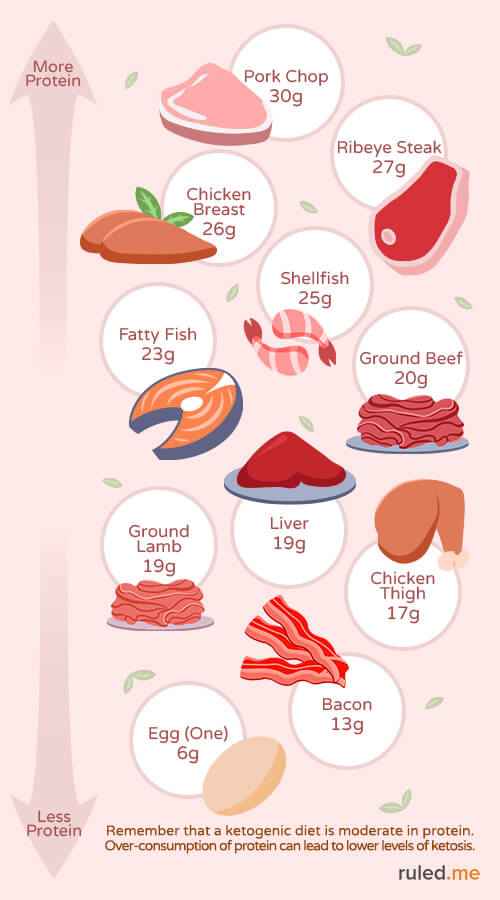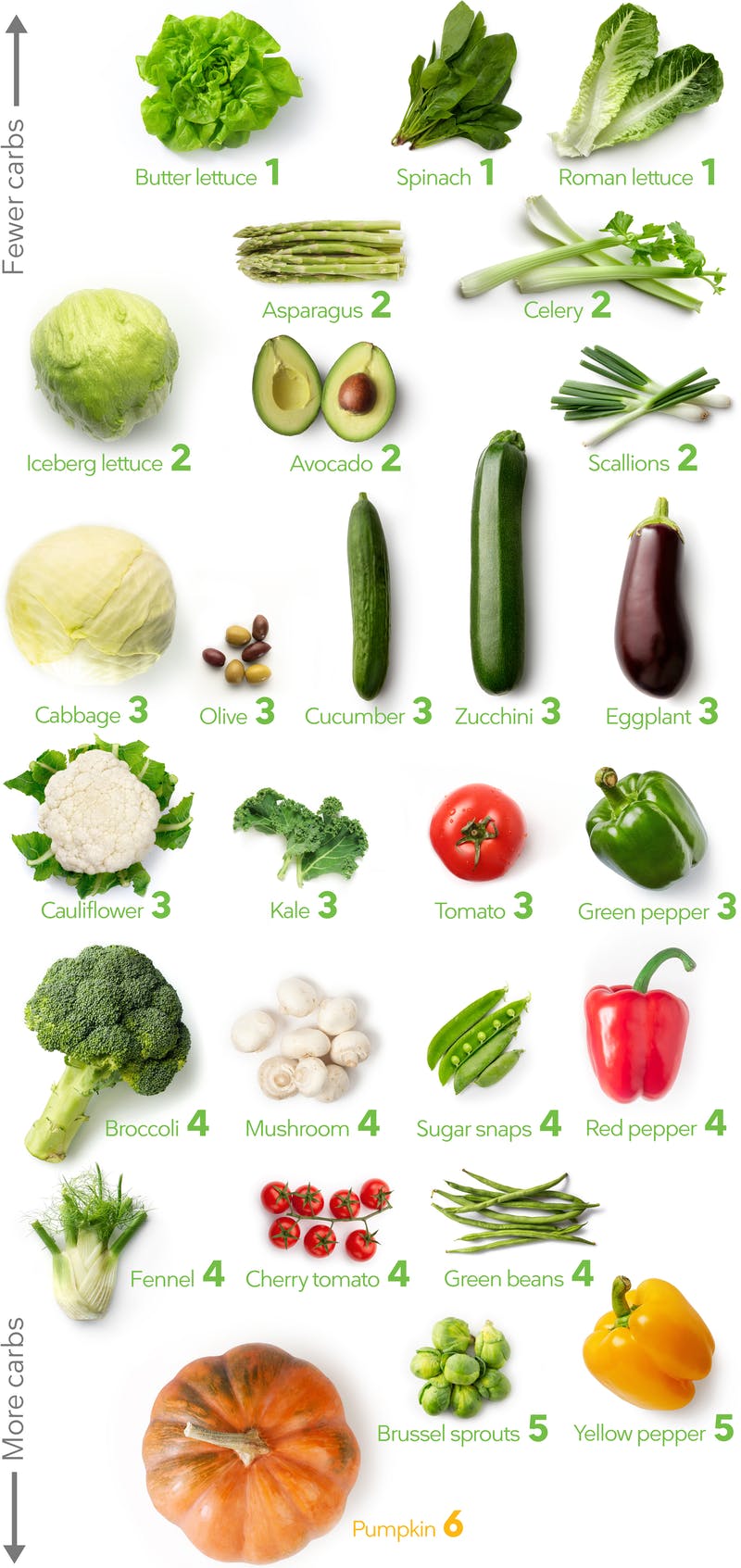Welcome to your first recipe!
Start by clicking the Recipe Editor tab above so you can begin adding ingredients.
Going on a diet or starting a change in habits doesn't have to be complicated, but the last thing you need when starting a keto diet is to have to continually question what you can and cannot eat.
What to eat on the Ketogenic diet?
With this post we want to make things a little easier for you, and that you have a quick reference at your fingertips of the vast majority of foods allowed on the ketogenic diet .
vegetables allowed on keto
Cruciferous vegetables that are grown above ground, green and leafy will be the best option.
- Chard
- Broccoli
- Zucchini
- Canons
- Cabbage (cabbage)
- Red cabbage
- Kale (kale or collard greens)
- Brussels sprouts
- Cauliflower
- Endives
- Spinach
- Sprouts (sprouts)
- Lettuce (radicchio, romaine, endive, trocadero, buds, etc)
- Tomato
- Cucumber
- Arugula
The 10 best keto veggies
Here are ten great keto veggies that are tasty and nutritious but with very little carbohydrates. We have tried to rank them according to their popularity and usefulness in keto cooking. All figures represent net carbs per 100 grams (3 ½ ounces).
Cauliflower - 3 g. Soft and very versatile in flavor. It is the base for cauliflower puree and cauliflower rice .
Avocado / Avocado 2 g. While technically a fruit, it is popularly considered among vegetables due to its use in meals. Packed with nutrients and healthy fats.
Avocado can be eaten in many different ways: alone, in salads, or to make guacamole . But this is only the beginning
Broccoli 4 g. It is used to replace pasta, rice or potatoes. You can steam it, fry it in butter , grill it in the oven, eat it with cheese sauce, sauté with bacon
Cabbage 3 g. Also known as cabbage, white cabbage is another excellent low-carb vegetable. It looks great sautéed in butter or in our popular Asian-style cabbage scramble .
Zucchini 3 g. Try our zucchini salad or our crunchy zucchini . Zucchini can also be sliced with a mandolin or spiralizer and used to cook keto pasta , like this carbonara or this lasagna .
Spinach 1 g. Spinach is very low in carbohydrates, and can be used raw in salads, baked, sauteed, or in sauces and creams. Try our popular spinach bacon omelette recipe or any of our other spinach recipes
Asparagus: 2 g. Satisfying, very nutritious and very low in carbohydrates. Try them wrapped in ham , in salad or in other delicious recipes
Kale 3 g. Also popularly known as Kale, her name is in English. It can be used raw in salads, baked to make chips , stir fry, or used as a base instead of pasta.
Green beans / Green beans / Green beans / Pods 4 g. This multi-name vegetable can be baked, steamed, or part of a stew, but perhaps the best way to bring out its flavor is by sautéing it in butter or bacon.
Brussels sprouts 5 g. These baby cabbages are especially good roasted with olive oil and garlic, or served in a creamy sauce.
Fats and oils
When following a ketogenic diet , fat makes up the vast majority of your calories. These foods will provide you with the high-quality fats you need:
- Avocado oil
- Coconut oil
- Extra virgin olive oil
- MCT oil (excellent dietary supplement that will give you a sustainable energy boost and help you stay in ketosis)
- Walnut oils
- Avocados
- Nuts (almonds, hazelnuts, walnuts. The macadamia nuts , pecans , pine nuts and Brazil nuts are particularly high fat levels)
- Ghee (clarified butter that does not contain lactose)
- Animal fat (such as lard)
- Butter (preferably organic and from grass-fed cows, since it contains a higher amount of CLA, Omega-3, vitamins K2, A, D and E. It also contains minerals such as selenium, magnesium, zinc or copper)
- Blue fish, rich in omega 3 fatty acids such as: salmon and smoked salmon, sardines, mackerel, tuna, pomfret, bonito, eel, swordfish ...
- Egg yolks
Protein
If you eat red meat or poultry, go for organic, grass-fed options. If you consume eggs, ideally choose organic or free-range eggs (codes 0 and 1).
Remember that the keto diet is moderate in protein .
- Beef, pork, lamb, poultry, organ meat (very rich in nutrients)
- Eggs
- Nut butters (100% natural, no added sugar)
- Seafood (prawns, mussels, clams, oysters, lobster and crabs)
- Fish

Fruit allowed on keto
- Avocado
- Blueberries
- Raspberries
- Strawberries
- Lemon and lime
- Blackberries
Dairy products
For some people, dairy products can cause bloating and inflammation. If you are not sensitive to dairy products, you have several high-fat options.
Always choose whole products, not 'light' or 'low-fat', since in them the fat has been replaced by added sugar.
Natural fermented dairy is also a very good option.
Kefir Cheese (cured Manchego, gouda, cheddar, mozzarella, brie, blue cheese, parmesan, feta ..) Milk (whole, quality and in small quantities since all the hydrates it contains are sugar) Liquid cream for cooking Plain yogurt (or Greek yogurt)
Nuts and seeds
Nuts and seeds are a perfect food for keto dieters. Underrated and often overlooked, they are packed with healthy nutrients.
We recommend buying them raw and roasting them, if you like, at home.
Brazil nuts Macadamia nuts Pecans Pumpkin seeds Sunflower seeds Chia seeds Flax seeds ( flax seeds) Sesame seeds Drinks Water (good hydration is especially important if you are losing weight on a ketogenic diet) Coffee (add coconut oil and / or a teaspoon of Erythritol for extra flavor, or MCT oil for extra energy) Green tea, Red tea Infusions Bone broth (good to replace electrolytes if we are fasting to prevent dehydration, as well as a good supply of collagen) Probiotic drinks and premium kombucha to improve gut health Spices and aromatic herbs
Virtually all spices and herbs are allowed on the keto diet, and they provide a host of health benefits.
Learn to include them in your kitchen, experiment and let your creativity fly! You will enjoy new flavors that you do not expect.
Basil Cinnamon Ceylan Cardamom chilli powder Cilantro Cumin Turmeric (great anti-inflammatory) Laurel Nutmeg Oregano Parsley Sweet or hot paprika Cayenne pepper Black pepper Ginger root powder Rosemary Salt Thyme Spice mixes etc Sweet Cocoa (pure) Erythritol and Stevia (for a low carb sweetener Chocolate without added sugar
Others
Probiotics to improve gut health (drink kombucha , eat kimchi, kefir, or sauerkraut) Unpasteurized apple cider vinegar (preferably organic)
If you are not following a strict ketogenic diet and therefore a bit more liberal, when you eat carbohydrates, try to avoid processed sources such as refined flours.
Organic produce that grows naturally will always be a better option for your overall health.
We hope that our list of foods allowed on the ketogenic diet will especially serve you during the first few weeks.
While ditching starchy carbs, grains, sugars, fruits, and alcohol may not be easy at first, we assure you that it will be much easier as you begin to physically notice the many benefits of the ketogenic diet!
What does ketogenic diet mean? A diet that is very low in carbohydrates but made up of many foods high in fat is called a ketogenic diet. The consequence of the keto diet is that the body changes its energy metabolism over the long term. With the classic ketogenic diet, only 20 grams of carbohydrates may be consumed per day. To make a comparison: As a rule, an adult should cover almost half of his energy needs with the consumption of carbohydrates. The ketogenic diet also includes a diet that consists of six to eight percent protein and 90 percent fats.
These foods are prohibited Sugar, potatoes, rice, bread and pasta are taboo here. Eggs, sausage, meat, fatty fish and vegetables are put on the plate - but only those that are low in carbohydrates. Fruit is only allowed in absolute quantities, as it contains a lot of fructose.
The right vegetables for the ketogenic diet Every food has certain concentrations of macronutrients, i.e. fat, protein and carbohydrates. The majority of dairy products and meat consists of a high concentration of fat and protein. Vegetables, on the other hand, consist mainly of carbohydrates. It is therefore important to know which vegetables contain the fewest carbohydrates in order to meet the requirement of less than 20 grams of carbohydrates in the ketogenic diet. Less than five percent of the carbohydrates Vegetables that contain less than five percent carbohydrates can be freely consumed during the keto diet. Sauces and butter can also be used here without a guilty conscience. These vegetables include:
Kale asparagus zucchini broccoli spinach Vegetables that have a higher proportion of carbohydrates, on the other hand, should be used sparingly. These vegetables include: green beans Brussels sprouts Carrots Kohlrabi red and yellow peppers Technically, the tomato is a fruit. Like the avocado, this can be integrated into the ketogenic diet. However, the carbohydrate content is a little higher in very ripe tomatoes.
More helpful tips When choosing vegetables that are low in carbohydrates, the following tips can be helpful.
The ketogenic-friendly vegetables usually include varieties that have leaves, such as spinach or lettuce. In general, green vegetables contain fewer carbohydrates than the brightly colored alternatives. For example, red cabbage has significantly more carbohydrates than kale. The same goes for the green peppers.
Fat and vegetables Vegetables that are suitable for the ketogenic diet can be wonderfully used as fat carriers. To do this, butter is simply used as a spice for the vegetables. Frying them in ghee, avocado oil, coconut oil, or lard is also a good way to prepare the vegetables in a keto-friendly way. Those who like to consume dairy products can conjure up a sauce made from cream cheese, cheese or cream.
To add more fat to the vegetables, they can also be dipped in salad dressing, olive oil or other dips. However, caution should be exercised with commercial dips, as they usually contain large amounts of carbohydrates. It is better to prepare the sauces and dips yourself.
Why are vegetables so important in the ketogenic diet? The fiber To provide the body with sufficient fiber, vegetables are a great source. Dietary fiber is essential for the health of the intestine, as it ensures the survival of the important intestinal bacteria. The body does not use the dietary fiber, but the fibers are used by the bacteria to replenish their energy stores.
Food for the brain A full 85 percent of the brain is made up of fat. From this it can be concluded that a diet that promotes the consumption of healthy fats such as coconut oil, ghee, MCT and omega 3 and 6 fatty acids is very good for the brain. However, these healthy fats cannot be used by the brain if the intestines are not working properly. Inflammation or malfunctions in the intestine can also impair the functioning of the brain. The intestine is the origin of a healthy body and therefore also a healthy brain.
The good bacteria in the intestine are supplied by the essential fiber. In addition, the vegetables provide necessary minerals and vitamins, such as magnesium, calcium, B vitamins, vitamin D and vitamin. Both the brain and the entire organism benefit from this.
Overcoming illnesses Plants carry out photosynthesis, even third grade students know that. During this process of photosynthesis, antibacterial and antifungal properties are activated in the plants, which protect them. And people take in this protection when they eat vegetables.
The ideal is of course to use organic vegetables that have not been genetically modified. Most of the valuable substances are contained here.


